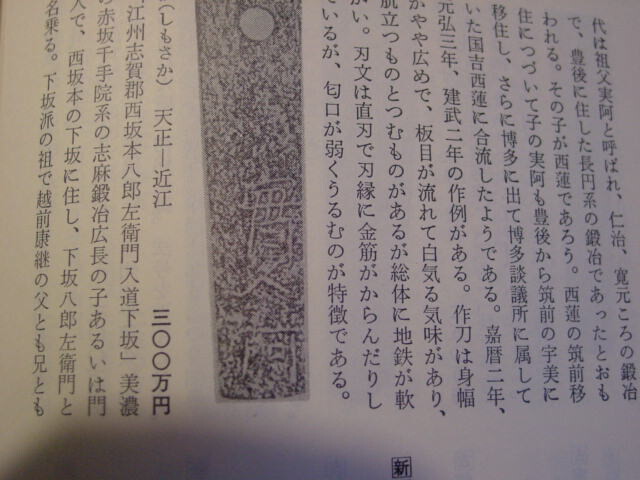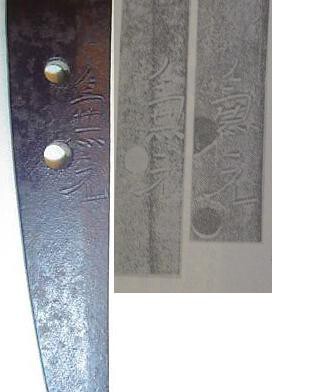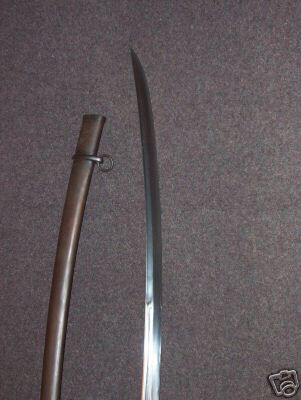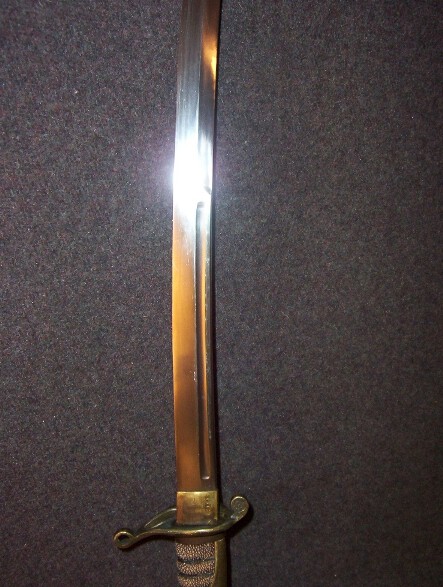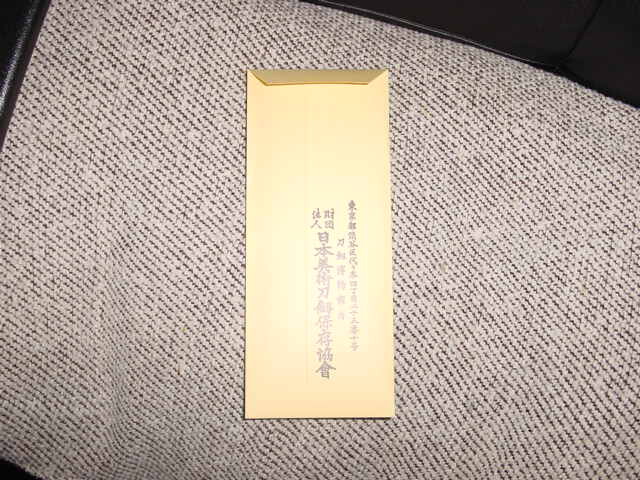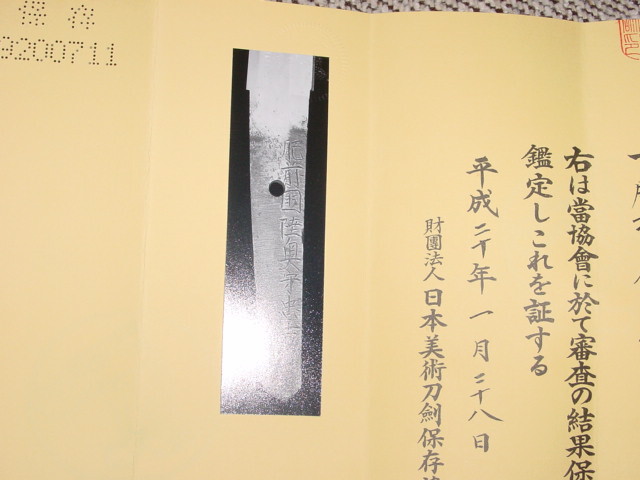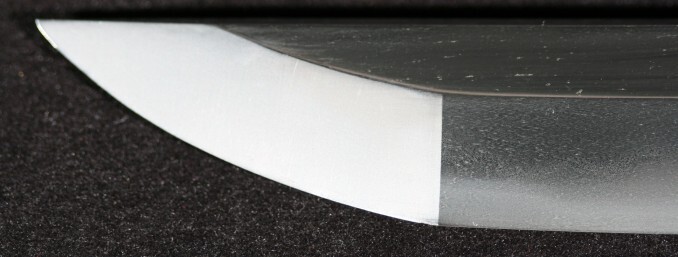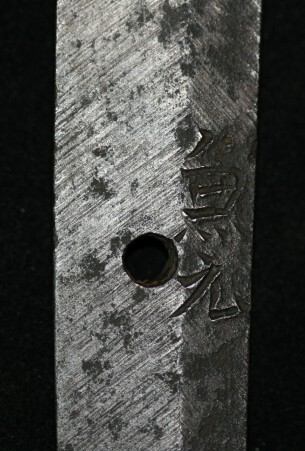-
Posts
264 -
Joined
-
Last visited
Content Type
Profiles
Forums
Events
Store
Downloads
Gallery
Everything posted by James
-

Another Kogarasu-maru in WWII Mounts?
James replied to James's topic in Auctions and Online Sales or Sellers
I feel sorry for the person who is going to win it (again). Here's the link to the original listing: http://cgi.ebay.com.au/ws/eBayISAPI.dll ... :IT&ih=016 Looks to be the same one just in this new listing the leather cover on the saya has been removed. -
This looks suspiciously close to the one bought by Max a few months ago... http://cgi.ebay.com/ws/eBayISAPI.dll?Vi ... :IT&ih=014
-
A good example of Nidai Masahiro: http://barryhennick.20megsfree.com/photo.html
-
Something seems to be very wrong with the exchange rate converter on PayPal. I have just received a payment of $2057.28USD (after fee) for a sword I sold, and PayPal has converted this to be $2073.42AUD. When I saw this, I was rather surprised because I thought it would be more than this. So I used PayPal's Currency Converter to check, and sure enough PayPal says that $2057.28USD = $2073.42AUD. But here's my problem... I then reversed the conversion i.e. I entered in $2073.42AUD to covert to USD, and according to PayPal's currency converter, $2073.42AUD = $1953.34USD. This makes no sense. How can it be that when I convert $2057.28USD to AUD I get $2073.42AUD, but when I convert $2073.42AUD to USD I get $1953.34USD? I think I'm being shortchanged here. I have checked on other Currency Conversion sites such as http://www.xe.com and they give equal conversion rates whether it be USD to AUD or AUD to USD. Any ideas?
-
Yes I agree, it is a bokken tsuba. I have the same kind of thing but plastic though I have seen some fancy bokken tsubas.
-

This should be interesting...
James replied to Leatherdog's topic in General Nihonto Related Discussion
-
I'm sorry but I'm not going to let this one die just yet. I've just acquired a Toko Taikan and looked up the Nidai there (page 136). Have a look at the following comparison. It looks pretty good to me, especially the first example.
-
Thanks for all the help guys. I have made it absolutely clear that a polished or faked hamon is unacceptable. The agent has now told me that he showed the sword to a master polisher who then confirmed the existence of the hamon. It seems a bit strange that he would wait until now to tell me that the master polisher said it was OK, but the agent's English is not very good so there's that limiting factor in our communication.
-
Thanks for that Brian Here's a new message from him after I asked if he thought it was Saiha or just burnt in a fire: Hello James, I do not feel signs of SAIHA in this sword. I was saying that your sword was burnt in the house fire maybe. Because the blade is thin in the whole. Please leave everything trusting us. So it seems that he just thought the blade may have been burnt in a fire because it is getting a bit thin (tired), but I think it's just because it has received some sandpaper work. I do remember asking Brian Pedersen togi if he thought it was too tired to take another polish and he thought it was fine, so at least I am hopeful now that it can still be restored.
-
I sent this sword to Japan for a fresh polish, but I'm baffled by the Japanese agent's comments. He seems to think that the blade isn't showing the hamon because it was burnt in a fire, which I replied saying that the blade isn't showing the hamon because at some point in time the sword has been buffed and/or taken to with fine sandpaper by a previous owner in the US, probably to remove the rust. I thoroughly assessed the sword before sending it and there was no pitting or other evidence or fire damage, it was just that the blade had been sandpapered by an ignorant past owner. But now after I asked for an update, here is what he replies with: Hello James, Please recognize the thing that the blade disappears to the sword when it is heated by strong heat. The blade starts disappearing because your sword received strong heat. It polishes by the specialized technique now to revive your blade. I think that it goes well maybe. The reason for the house in old Japan is that it is made of the tree and paper and burns easily such a lot of swords are in Japan. Only the blade's remaining should express gratitude to your sword for luck. Thank you Can anyone make sense of this?
-
Hi Jacques Although your comment is somewhat justified, just know that I didn't just run straight to the board when I saw the sword. I researched the different generations, and formed the opinion that it seemed to be the Nidai. Then I came here to see if other's would agree. I was wrong, and now have learnt why I was wrong. But thanks for expressing your concern and for the oshigata.
-
Have a look at these links of Magaroku and let me know what you think: http://www.d8.dion.ne.jp/~y.noda/KANEMOTO.html http://www.users.on.net/~coxm/oshigata% ... %20k8.html http://www.users.on.net/~coxm/oshigata% ... %20k9.html
-
Could this one be by the Nidai? I've found a few of his swords on the net and the mei's seem to be a close match. Also the style of sanbonsugi seem to be very similar. I can't get any additional photos at the moment.
-
-
Here's a sword I just recently picked up. It's in transit from the US so all I can give at the moment is a few photos. My hope is that someone may be able to tell me straight off if I've bought a piece of junk here. I don't think it is a low grade factory sword simply due to it's tsurikomi. Anyway, I'm a novice so other opinions would be helpful.
-
Thanks for the clarification and the link
-
I was considering u-no-kubi but I guess I must've got caught out thinking that the lower part of the sword had to be shinogi-zukuri style to be defined as being either kanmuri-otoshi or u-no-kubi. Is this not true? The lower half of the sword in question is hira-zukuri but it sounds like it doesn't matter which style the lower half is in.
-
Hello all There are two wakizashi I have come across that are rather interesting. The first features what I believe is referred to a Mimigata hamon, and since this seems to be an uncommon hamon, perhaps determining the smith will not be difficult. The nakago patina suggests late Shinto or Shin-shinto, and the yasurimei suggests Yamato. Please have a look at the photos, and all comments are most welcome. The second wakizashi has an interesting tsukurikomi that I'm yet to identify. I would have said it was kanmuri-otoshi but there is no shinogi in the lower part of the blade. Not sure where to go on this one, so any help is appreciated.
-
-
-
You guys are great. Thanks for solving this one for me.
-
From John's photo I think we could safely assume that the sword in question is an earlier generation - perhaps 25th or 26th generation?
-
Does anyone have an oshigata for comparison? As Jacques suggested, it would probably be a Sukesada from the Gendai era.
-
Hello everyone, Does anyone know which Kanemoto this piece could be forged by? Please note that the patina on the nakago isn't as new as it appears to be on the close up of the mei. Have a look at the first photo to see a more accurate patination colour.
-
Hello all I've seen a few swords that have rather complex hamons and what appears to almost be a break in the hamon such as the example below. Some hamons I have seen come even closer to having breaks like this. Is there any problem with a sword having one or several of these 'near breaks' in the hamon?



